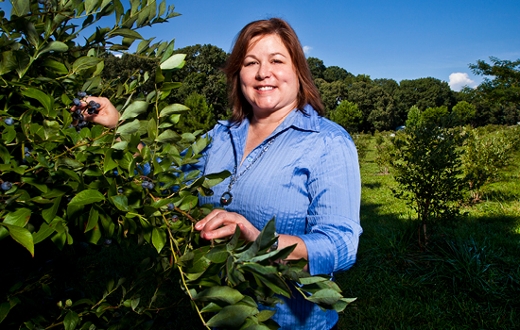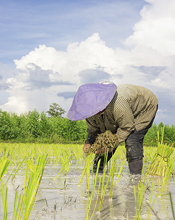Each morning, millions of women across Thailand trek to work at one of the country's many farms. Before they head out to start a long day of picking fruits and vegetables, they wrap cloth around their faces to help avoid breathing in pesticides sprayed on farms to protect crops.
Half of the country's job force works in agriculture and routinely are exposed to toxic, environmentally persistent, and cheap chemicals used extensively throughout Thailand and other developing countries. While pesticides help protect crops, they also put farm workers and the estimated 400,000 babies born yearly to women who work in agriculture at risk for serious health problems.
The country does have laws governing pesticide use, but its enforcement of them is lax, says Dana Boyd Barr, research professor of environmental health at Rollins.
"Thailand's policies governing the use of pesticides are very broken," she says. "Four different ministries in Thailand make the rules governing pesticide use."
Haphazard governance and lack of personal protection gear put pregnant women at risk, Barr says. By studying the issue, she wants to pinpoint when pesticide exposure is most harmful to a baby's development during pregnancy.
"There are about 80,000 pesticides out there worldwide, and very few of them have been studied for exposure in humans or for long-term exposure," she says. "I want to try to understand what parents, and moms in particular, can do during pregnancy to attenuate negative outcomes. If we can't eliminate exposure, then we should do everything we can to lessen exposure."
|
Barr's research team recently completed a pilot study in Thailand in which they found that pesticide exposure in a woman's second trimester increased the risk of impaired motor development in babies. A first-trimester exposure likely affected a baby's reflex development.
An analytical chemist by training, Barr also has been involved in the four largest studies in the world looking at organophosphate pesticide exposure in children. The studies, from 1998 to 2003, looked at organophosphate pesticide (common insecticides) exposure among children, from in utero to age 7 in California, New York, and Ohio. Collectively, the four studies found that children had a higher risk of delayed development, attention deficit hyperactivity disorder, and an IQ deficit that was twice the level observed in children with lead poisoning.
"There are some gaps in pesticide exposure research, but on the other side is industry," Barr says. "Pesticides are a big moneymaker for companies, and often the regulatory agency is caught in the middle. Sometimes we need more complete research. It's an ever-changing field. As one class of pesticides fades, another one comes into play. Often, when you find out one pesticide's use patterns and identify the population that is affected, industry may have moved on to another product."
Barr, who built a two-decade career at the CDC before joining Rollins four years ago, hopes that the Environmental Protection Agency will change its policy regarding use of organophosphate pesticide to better protect pregnant women. "We at Rollins are not just doing research to do research," she says. "We are doing research to translate into policy to ensure that the future for our mothers and children will be better."


